You’ll discover that hanging plants can transform your living space by drawing the eye upward and creating visual interest without sacrificing valuable floor space. These seven versatile options offer distinct features: trailing vines that can grow up to 30 feet, unique foliage patterns, and varying maintenance needs. Whether you’re looking to fill a sunny window or brighten a dark corner, there’s a perfect hanging plant waiting to enhance your indoor environment.
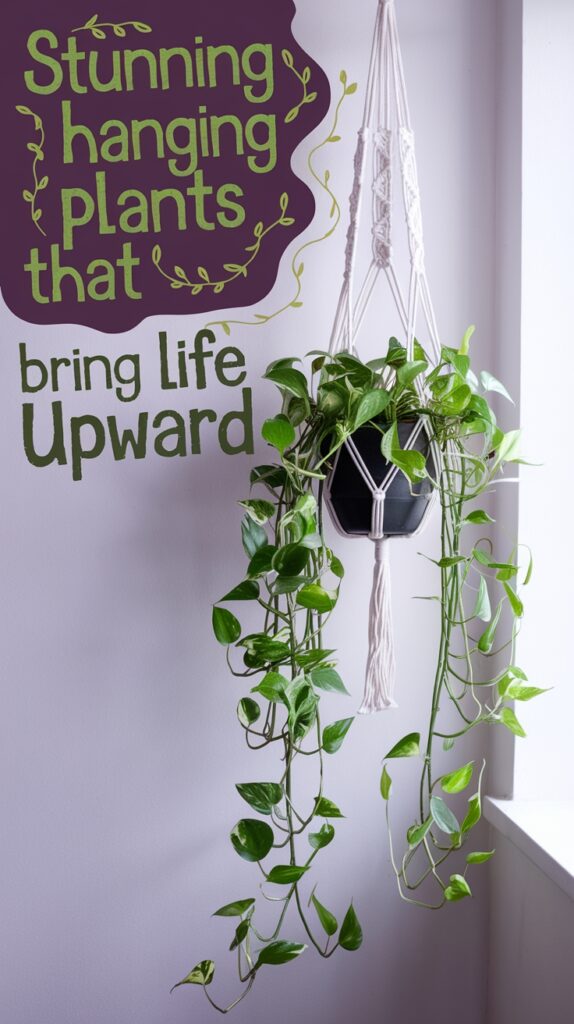
Contents
Pothos: The Classic Cascading Beauty
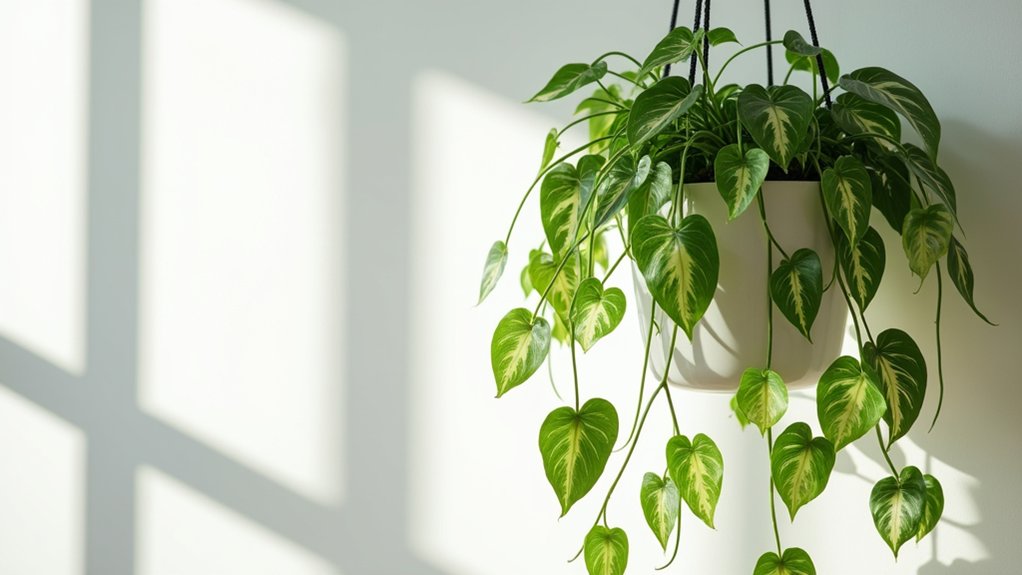
Pothos (Epiphorbia aureum) is a beloved trailing houseplant known for its heart-shaped leaves and versatile growing habits. This tropical vine features glossy foliage that comes in various patterns, including solid green, marbled yellow-and-green (golden pothos), and white-speckled varieties (marble queen). The vines can grow several feet long, making them perfect for hanging baskets, wall cascades, or climbing supports, while their aerial roots allow them to naturally attach to surfaces as they grow.
- Light: Tolerates low to bright indirect light; avoid direct sunlight
- Water: Allow top 1-2 inches of soil to dry between waterings
- Soil: Well-draining potting mix with good aeration
- Humidity: Adapts to average indoor humidity levels
- Temperature: Thrives in 60-80°F (15-27°C)
- Fertilizer: Monthly feeding with balanced liquid fertilizer during growing season
Regular pruning helps maintain a full, bushy appearance and prevents leggy growth in pothos plants. Trim long vines just above a leaf node to encourage branching, and remove any yellowed or damaged leaves promptly.
Wipe leaves occasionally with a damp cloth to remove dust and maintain their natural shine. While pothos is generally pest-resistant, inspect regularly for common houseplant pests like mealybugs and spider mites, especially in dense growth areas where issues can go unnoticed.
String of Pearls: Living Beaded Curtains
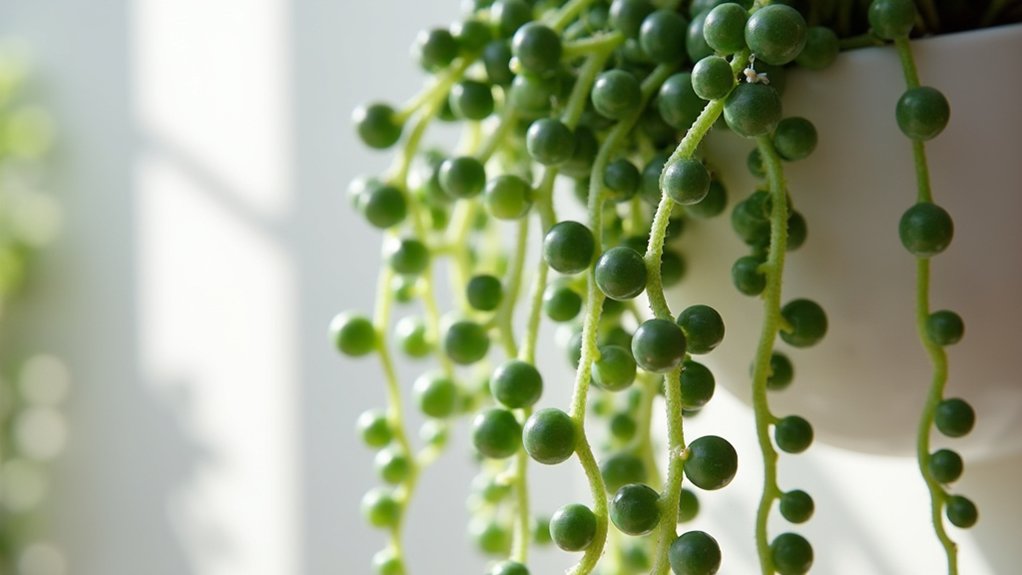
String of Pearls (Senecio rowleyanus) creates a mesmerizing cascade of small, round leaves that resemble a living beaded curtain when grown in hanging baskets.
These succulent trailing vines can grow several feet long, with perfectly spherical leaves strung along delicate stems like glossy green pearls. The unique bead-like foliage serves as water storage, and when happy, the plant produces tiny white flowers with a sweet cinnamon scent.
Growing Conditions:
- Bright, indirect light with some direct morning sun
- Well-draining succulent or cactus soil mix
- Water only when top 1-2 inches of soil feels dry
- Temperature range of 70-80°F (21-27°C)
- Moderate to high humidity
- Hanging container with drainage holes
- Monthly feeding during growing season with diluted succulent fertilizer
Regular pruning helps maintain the plant’s desired shape and promotes fuller growth, while removing any dried or yellowing strands prevents disease spread.
Monitor the soil moisture carefully, as both overwatering and underwatering can cause the pearls to shrivel or burst.
Rotate the container quarterly to ensure even growth, and dust the pearls gently with a soft brush to maintain their characteristic shine and prevent pest issues.
Spider Plant: The Prolific Producer
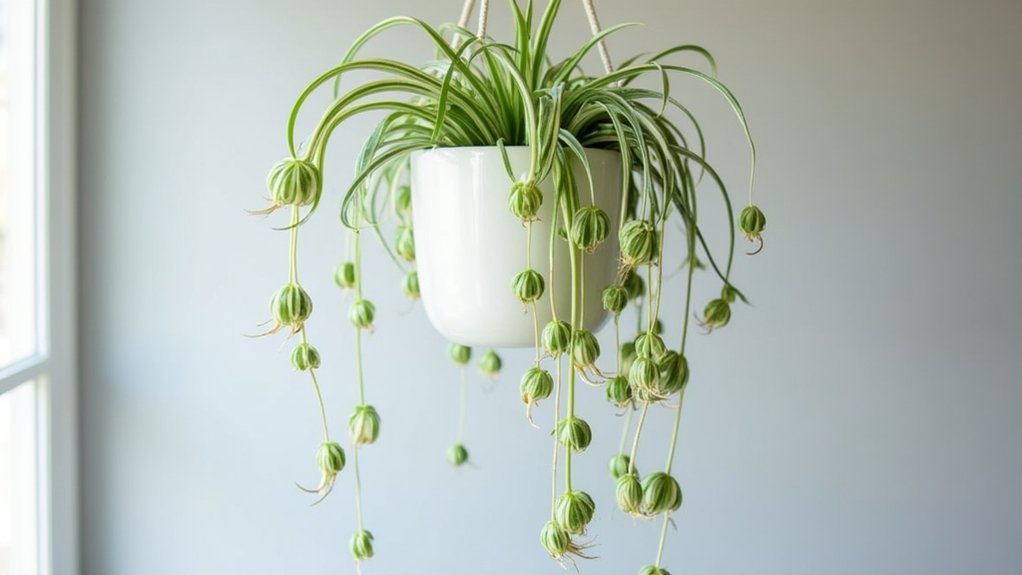
Spider Plants (Chlorophytum comosum) are graceful hanging plants known for their arching, grass-like foliage and cascading habit. The most distinctive feature is their production of long stems called stolons, which produce baby plants, or “spiderettes,” dangling like spiders on a web.
These plantlets make them excellent candidates for propagation and create a dramatic cascading effect, especially in hanging baskets. The leaves can be solid green or variegated with white or yellow stripes running lengthwise.
- Light: Bright indirect light to partial shade; avoid direct sunlight
- Water: Keep soil moderately moist; allow top inch to dry between waterings
- Humidity: Tolerates average household humidity levels
- Temperature: 60-75°F (15-24°C)
- Soil: Well-draining potting mix
- Fertilizer: Feed monthly during growing season with balanced fertilizer
- Container: Hanging basket or pot with drainage holes
Regular grooming keeps Spider Plants looking their best and promotes healthy growth. Remove any brown or yellow leaves by cutting them at the base.
When spiderettes become too numerous or heavy, either remove them to start new plants or trim them off to redirect energy to the mother plant. Repot every 2-3 years when roots become crowded, and flush the soil every few months to prevent salt buildup from fertilizers, which can cause brown leaf tips.
Boston Fern: Timeless Green Elegance
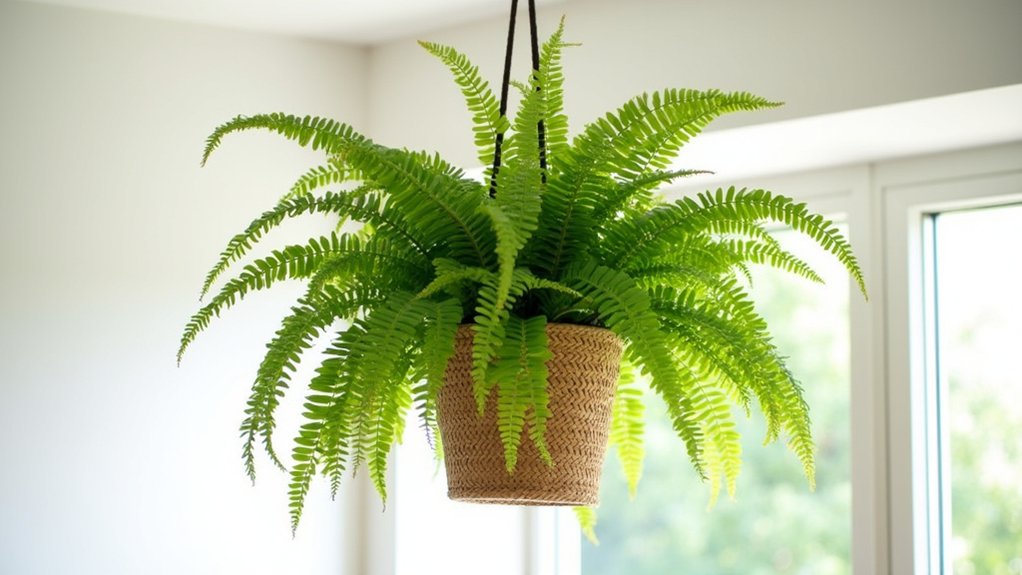
The Boston Fern (Nephrolepis exaltata) showcases graceful, arching fronds with delicate, feather-like leaflets that cascade downward, creating a classic hanging basket display. This timeless plant features bright to deep green foliage that can reach lengths of 2-3 feet, forming a symmetrical, fountain-like shape that adds sophisticated elegance to any indoor space.
Its lush, layered appearance and natural draping tendency make it one of the most popular hanging ferns for indoor decoration.
Growing Conditions:
- Light: Bright, indirect sunlight; avoid direct sun exposure
- Humidity: High humidity (60-80%); use a humidity tray or regular misting
- Temperature: 60-75°F (16-24°C)
- Soil: Well-draining, rich potting mix with high organic content
- Water: Keep soil consistently moist but not waterlogged
- Fertilizer: Feed monthly with balanced, water-soluble fertilizer during growing season
Regular grooming is essential for maintaining a Boston Fern’s attractive appearance and health. Remove any yellowed or brown fronds at the base using clean, sharp scissors.
Rotate the plant weekly to ensure even growth, and periodically check for signs of pests, particularly spider mites and mealybugs.
To prevent the plant from becoming too large or unruly, trim back older fronds in early spring before new growth begins, and divide overcrowded plants every 2-3 years to maintain vigor and shape.
English Ivy: Traditional Trailing Charm
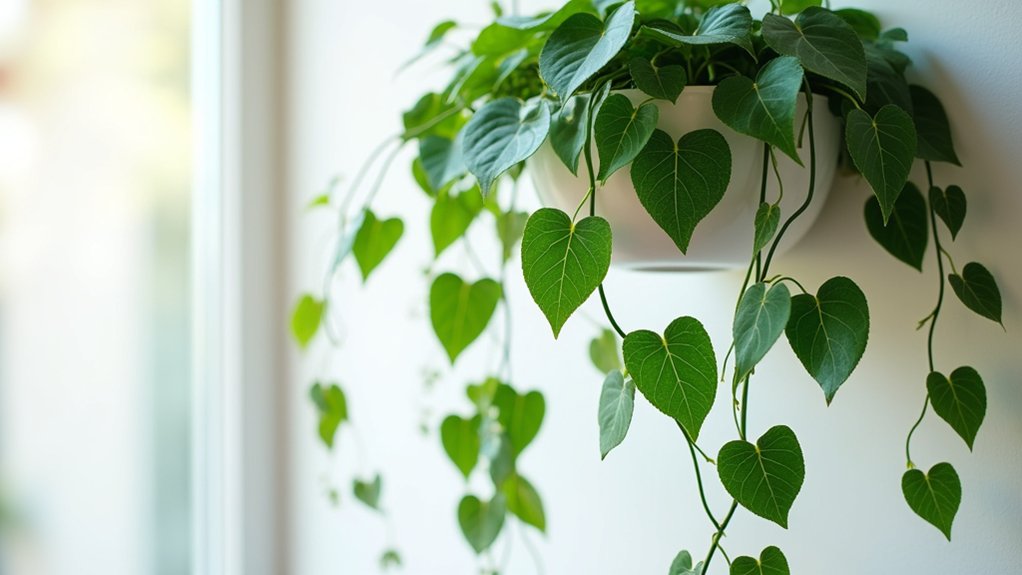
English Ivy (Hedera helix) is a classic trailing plant known for its elegant, heart-shaped leaves and versatile growing habit. This evergreen vine features deep green, glossy foliage with distinctive white veining patterns, and can cascade gracefully from hanging baskets or climb walls and trellises. Its long, winding stems can grow several feet in length, creating a lush, romantic aesthetic that has made it a timeless choice for indoor spaces.
- Light: Bright indirect light; can tolerate moderate shade but avoid direct sunlight
- Water: Keep soil consistently moist but not waterlogged; water when top inch of soil feels dry
- Humidity: Prefers moderate to high humidity; mist regularly
- Temperature: 60-75°F (15-24°C)
- Soil: Well-draining potting mix rich in organic matter
- Fertilizer: Feed monthly during growing season with balanced liquid fertilizer
Regular pruning is essential to maintain English Ivy‘s shape and prevent it from becoming too leggy or overwhelming its space. Remove yellowed or damaged leaves promptly, and trim back overgrown vines to encourage fuller growth.
Dust the leaves periodically to maintain their glossy appearance and ensure proper photosynthesis. Watch for common pests like spider mites and scale insects, especially in dry conditions, and treat immediately with insecticidal soap if detected.
Rotating the plant quarterly ensures even growth and prevents the vines from becoming too dense on one side.
Philodendron Brasil: Vibrant Vines
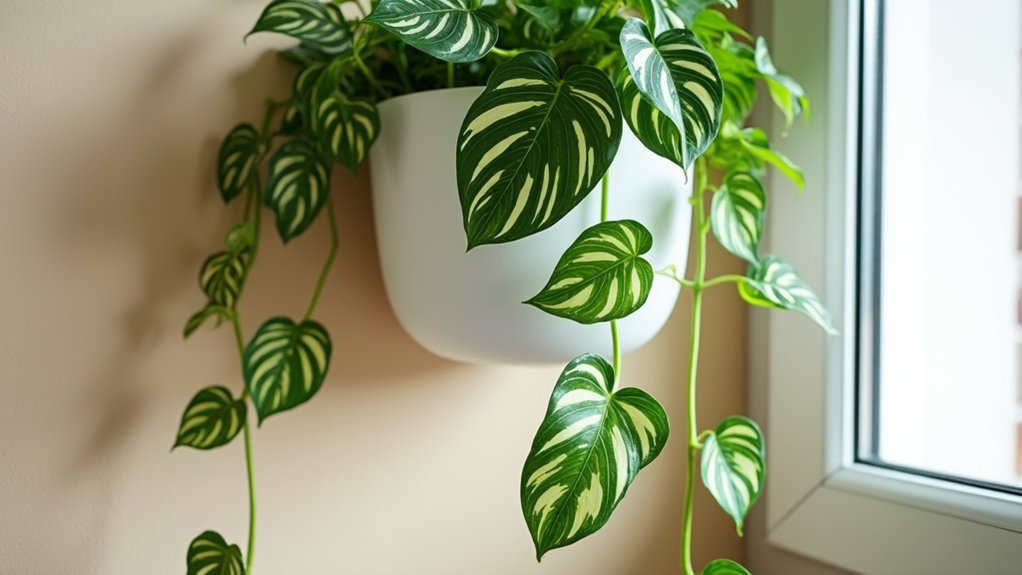
Philodendron Brasil is a stunning tropical vine characterized by its heart-shaped leaves featuring unique variegation patterns of dark and lime green, often with cream-colored streaks. This variety of the classic heartleaf philodendron displays more vibrant coloring than its cousins, with each leaf presenting a slightly different pattern, making it a visually dynamic choice for hanging baskets or climbing displays.
- Light: Bright, indirect light; can tolerate medium light but may lose variegation in low light conditions
- Water: Allow top 1-2 inches of soil to dry between waterings
- Soil: Well-draining, rich potting mix with added perlite
- Humidity: Prefers 60% or higher
- Temperature: 65-80°F (18-27°C)
- Fertilizer: Monthly feeding during growing season with balanced liquid fertilizer
Regular pruning of lengthy vines encourages bushier growth and prevents the plant from becoming leggy.
Remove any yellow or damaged leaves promptly, and wipe the leaves monthly with a damp cloth to remove dust and maintain optimal photosynthesis.
Training the vines on a support structure or allowing them to cascade naturally will showcase the plant’s natural growth pattern, while periodic rotation ensures even growth on all sides.
String of Hearts: Delicate Danglers
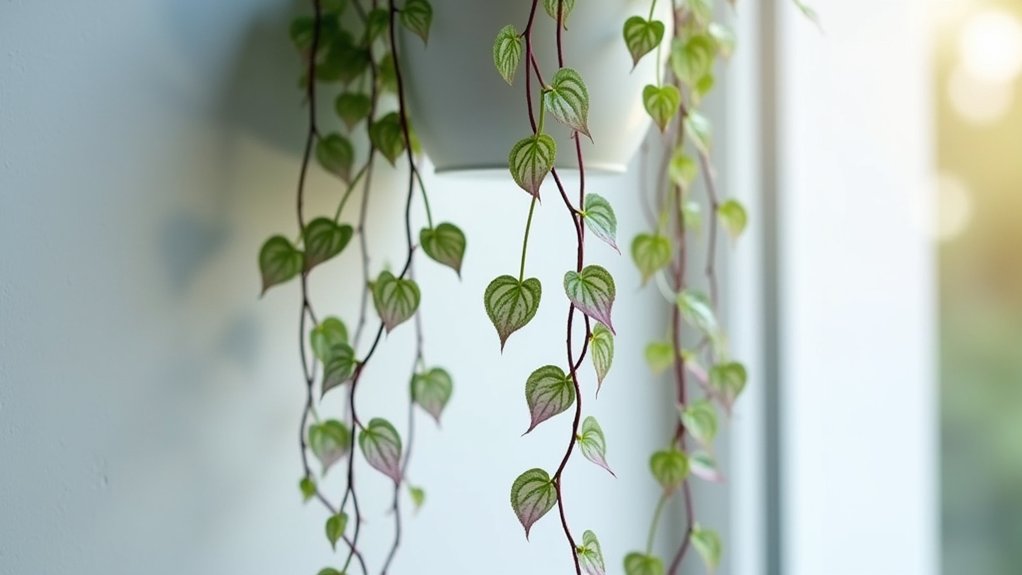
String of Hearts (Ceropegia woodii) is a charming trailing succulent featuring delicate, heart-shaped leaves that cascade down in long, slender vines. The leaves display a striking variegated pattern of silver marbling against green backgrounds, occasionally featuring purple undersides. This dainty plant can grow several feet long, creating an elegant waterfall effect with its thin, purple-tinted stems and petite foliage that resembles a string of tiny hearts.
- Light: Bright, indirect light; can tolerate some direct morning sun
- Water: Allow soil to dry between waterings; water sparingly in winter
- Soil: Well-draining succulent or cactus mix
- Temperature: 65-80°F (18-27°C)
- Humidity: Average household humidity; tolerates dry conditions
- Fertilizer: Light feeding with balanced fertilizer during growing season
- Pot Requirements: Small to medium containers with drainage holes
Regular pruning and vine management are essential for maintaining a full, healthy String of Hearts. Trim leggy growth to encourage bushiness and remove any yellowed or damaged leaves promptly.
The plant can be propagated easily through stem cuttings or by laying stem segments with nodes on soil. During winter, reduce watering frequency and pause fertilization to match the plant’s natural dormancy period.
Regularly check the soil moisture by inserting a finger into the top inch, as overwatering is the primary cause of problems with this species.
